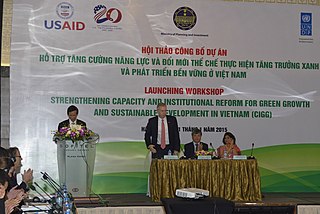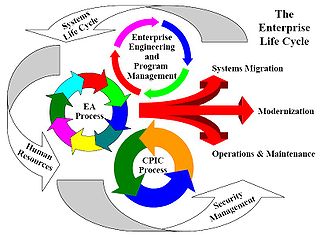Project management is the process of leading the work of a team to achieve all project goals within the given constraints. This information is usually described in project documentation, created at the beginning of the development process. The primary constraints are scope, time, and budget. The secondary challenge is to optimize the allocation of necessary inputs and apply them to meet pre-defined objectives.
In common usage, evaluation is a systematic determination and assessment of a subject's merit, worth and significance, using criteria governed by a set of standards. It can assist an organization, program, design, project or any other intervention or initiative to assess any aim, realisable concept/proposal, or any alternative, to help in decision-making; or to ascertain the degree of achievement or value in regard to the aim and objectives and results of any such action that has been completed.

Business performance management (BPM), also known as corporate performance management (CPM) enterprise performance management (EPM), organizational performance management, or simply performance management are a set of management and analytic processes that ensure activities and outputs meet an organization's goals in an effective and efficient manner. Business performance management is contained within approaches to business process management.
Program evaluation is a systematic method for collecting, analyzing, and using information to answer questions about projects, policies and programs, particularly about their effectiveness and efficiency.
Governance is the process of making and enforcing decisions within an organization or society. It is the process of interactions through the laws, social norms, power or language as structured in communication of an organized society over a social system. It is done by the government of a state, by a market, or by a network. It is the process of choosing the right course among the actors involved in a collective problem that leads to the creation, reinforcement, or reproduction of acceptable conduct and social order". In lay terms, it could be described as the political processes that exist in and between formal institutions.
Information technology (IT)governance is a subset discipline of corporate governance, focused on information technology (IT) and its performance and risk management. The interest in IT governance is due to the ongoing need within organizations to focus value creation efforts on an organization's strategic objectives and to better manage the performance of those responsible for creating this value in the best interest of all stakeholders. It has evolved from The Principles of Scientific Management, Total Quality Management and ISO 9001 Quality management system.
A business case captures the reasoning for initiating a project or task. Many projects, but not all, are initiated by using a business case. It is often presented in a well-structured written document, but may also come in the form of a short verbal agreement or presentation. The logic of the business case is that, whenever resources such as money or effort are consumed, they should be in support of a specific business need. An example could be that a software upgrade might improve system performance, but the "business case" is that better performance would improve customer satisfaction, require less task processing time, or reduce system maintenance costs. A compelling business case adequately captures both the quantifiable and non-quantifiable characteristics of a proposed project. According to the Project Management Institute, a business case is a "value proposition for a proposed project that may include financial and nonfinancial benefit."
Social return on investment (SROI) is a principles-based method for measuring extra-financial value. It can be used by any entity to evaluate impact on stakeholders, identify ways to improve performance, and enhance the performance of investments.

Capacity building is the improvement in an individual's or organization's facility "to produce, perform or deploy". The terms capacity building and capacity development have often been used interchangeably, although a publication by OECD-DAC stated in 2006 that capacity development was the preferable term. Since the 1950s, international organizations, governments, non-governmental organizations (NGOs) and communities use the concept of capacity building as part of "social and economic development" in national and subnational plans. The United Nations Development Programme defines itself by "capacity development" in the sense of "'how UNDP works" to fulfill its mission. The UN system applies it in almost every sector, including several of the Sustainable Development Goals to be achieved by 2030. For example, the Sustainable Development Goal 17 advocates for enhanced international support for capacity building in developing countries to support national plans to implement the 2030 Agenda.
Organizational effectiveness is a concept organizations use to gauge how effective they are at reaching intended outcomes. Organizational effectiveness is both a powerful and problematic term. The strength of it is that it may be used to critically evaluate and improve organisational activities. It's problematic since it means various things to different individuals. And there are other alternative methods for measuring organizational performance. Organizational effectiveness embodies the degree to which firms achieve the goals they have decided upon, a question that draws on several different factors. Among those are talent management, leadership development, organization design and structure, design of measurements and scorecards, implementation of change and transformation, deploying smart processes and smart technology to manage the firms' human capital and the formulation of the broader Human Resources agenda.

Internal auditing is an independent, objective assurance and consulting activity designed to add value and improve an organization's operations. It helps an organization accomplish its objectives by bringing a systematic, disciplined approach to evaluate and improve the effectiveness of risk management, control and governance processes. Internal auditing might achieve this goal by providing insight and recommendations based on analyses and assessments of data and business processes. With commitment to integrity and accountability, internal auditing provides value to governing bodies and senior management as an objective source of independent advice. Professionals called internal auditors are employed by organizations to perform the internal auditing activity.

Logic models are hypothesized descriptions of the chain of causes and effects leading to an outcome of interest. While they can be in a narrative form, logic model usually take form in a graphical depiction of the "if-then" (causal) relationships between the various elements leading to the outcome. However, the logic model is more than the graphical depiction: it is also the theories, scientific evidences, assumptions and beliefs that support it and the various processes behind it.

Sustainability accounting was originated about 20 years ago and is considered a subcategory of financial accounting that focuses on the disclosure of non-financial information about a firm's performance to external stakeholders, such as capital holders, creditors, and other authorities. Sustainability accounting represents the activities that have a direct impact on society, environment, and economic performance of an organisation. Sustainability accounting in managerial accounting contrasts with financial accounting in that managerial accounting is used for internal decision making and the creation of new policies that will have an effect on the organisation's performance at economic, ecological, and social level. Sustainability accounting is often used to generate value creation within an organisation.

Enterprise life cycle (ELC) in enterprise architecture is the dynamic, iterative process of changing the enterprise over time by incorporating new business processes, new technology, and new capabilities, as well as maintenance, disposition and disposal of existing elements of the enterprise.
Capability management is the approach to the management of an organization, typically a business organization or firm, based on the "theory of the firm" as a collection of capabilities that may be exercised to earn revenues in the marketplace and compete with other firms in the industry. Capability management seeks to manage the stock of capabilities within the firm to ensure its position in the industry and its ongoing profitability and survival.

Theory of Change (ToC) is a methodology or a criterion for planning, participation, adaptive management, and evaluation that is used in companies, philanthropy, not-for-profit, international development, research, and government sectors to promote social change. Theory of Change defines long-term goals and then maps backward to identify necessary preconditions.
In organizational theory, organizational analysis or industrial analysis is the process of reviewing the development, work environment, personnel, and operation of a business or another type of association. This review is often performed in response to crisis, but may also be carried out as part of a demonstration project, in the process of taking a program to scale, or in the course of regular operations. Conducting a periodic detailed organizational analysis can be a useful way for management to identify problems or inefficiencies that have arisen in the organization but have yet to be addressed, and develop strategies for resolving them.

Management accounting principles (MAP) were developed to serve the core needs of internal management to improve decision support objectives, internal business processes, resource application, customer value, and capacity utilization needed to achieve corporate goals in an optimal manner. Another term often used for management accounting principles for these purposes is managerial costing principles. The two management accounting principles are:
- Principle of Causality and,
- Principle of Analogy.
The Donabedian model is a conceptual model that provides a framework for examining health services and evaluating quality of health care. According to the model, information about quality of care can be drawn from three categories: “structure,” “process,” and “outcomes." Structure describes the context in which care is delivered, including hospital buildings, staff, financing, and equipment. Process denotes the transactions between patients and providers throughout the delivery of healthcare. Finally, outcomes refer to the effects of healthcare on the health status of patients and populations. Avedis Donabedian, a physician and health services researcher at the University of Michigan, developed the original model in 1966. While there are other quality of care frameworks, including the World Health Organization (WHO)-Recommended Quality of Care Framework and the Bamako Initiative, the Donabedian Model continues to be the dominant paradigm for assessing the quality of health care.
Information culture is closely linked with information technology, information systems, and the digital world. It is difficult to give one definition of information culture, and many approaches exist.






